Analysis and Evaluation of Financing Options for Bayer: ACC7046 Financial Strategy
VerifiedAdded on 2023/06/11
|10
|2718
|343
AI Summary
This report analyses and evaluates the financing options available to Bayer for raising finance to expand the business. It deeply evaluates the various financing alternatives and recommends the financing options best suited for Bayer.
Contribute Materials
Your contribution can guide someone’s learning journey. Share your
documents today.
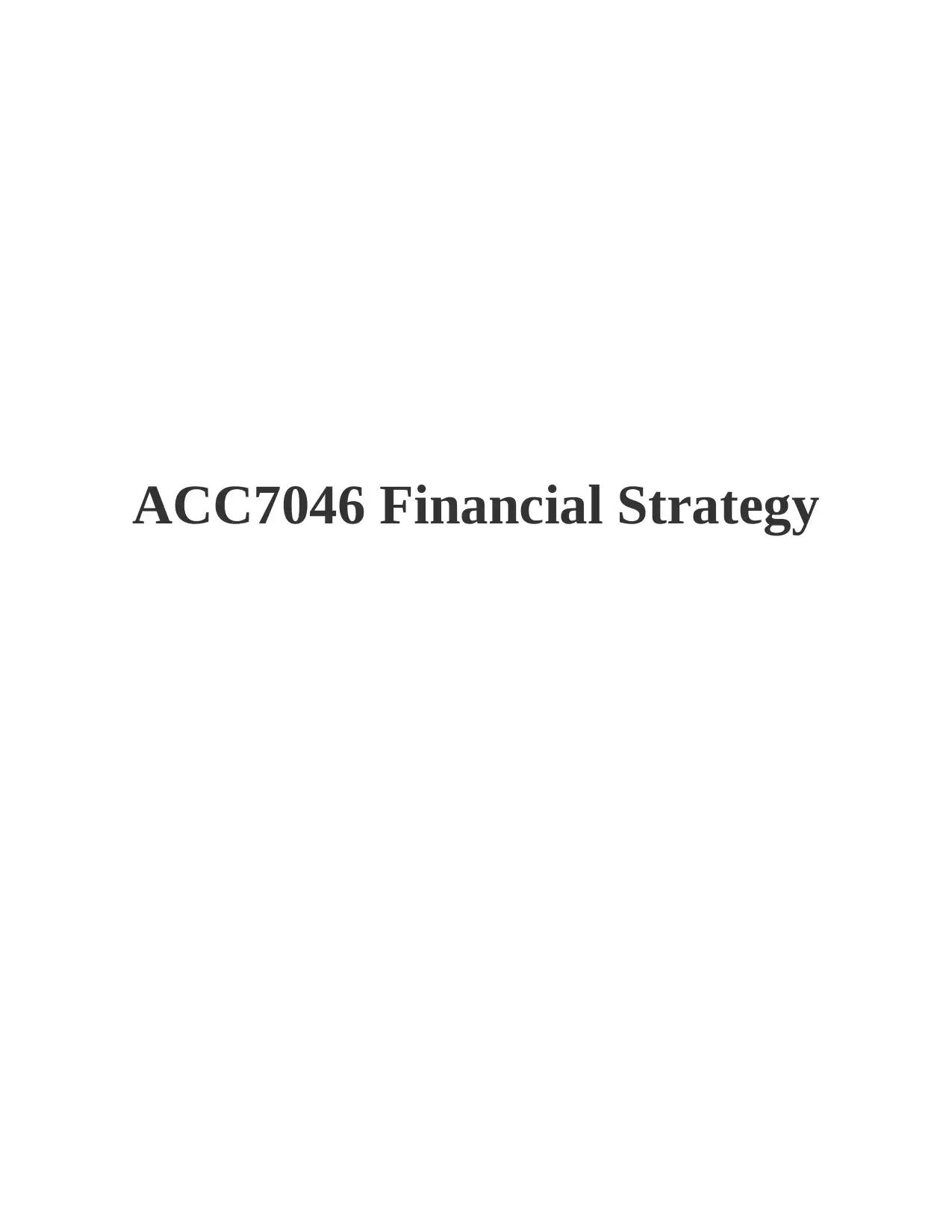
ACC7046 Financial Strategy
Secure Best Marks with AI Grader
Need help grading? Try our AI Grader for instant feedback on your assignments.
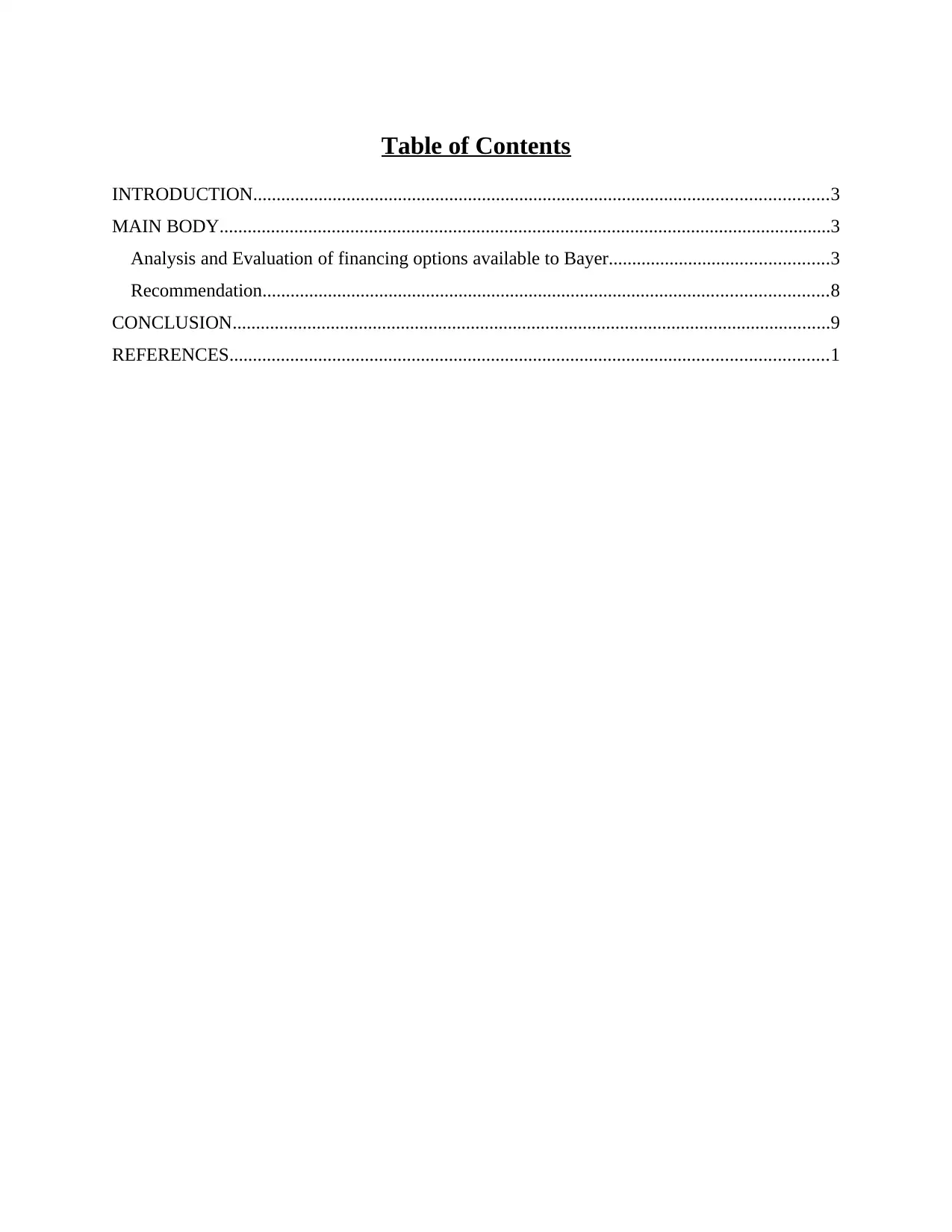
Table of Contents
INTRODUCTION...........................................................................................................................3
MAIN BODY...................................................................................................................................3
Analysis and Evaluation of financing options available to Bayer...............................................3
Recommendation.........................................................................................................................8
CONCLUSION................................................................................................................................9
REFERENCES................................................................................................................................1
INTRODUCTION...........................................................................................................................3
MAIN BODY...................................................................................................................................3
Analysis and Evaluation of financing options available to Bayer...............................................3
Recommendation.........................................................................................................................8
CONCLUSION................................................................................................................................9
REFERENCES................................................................................................................................1
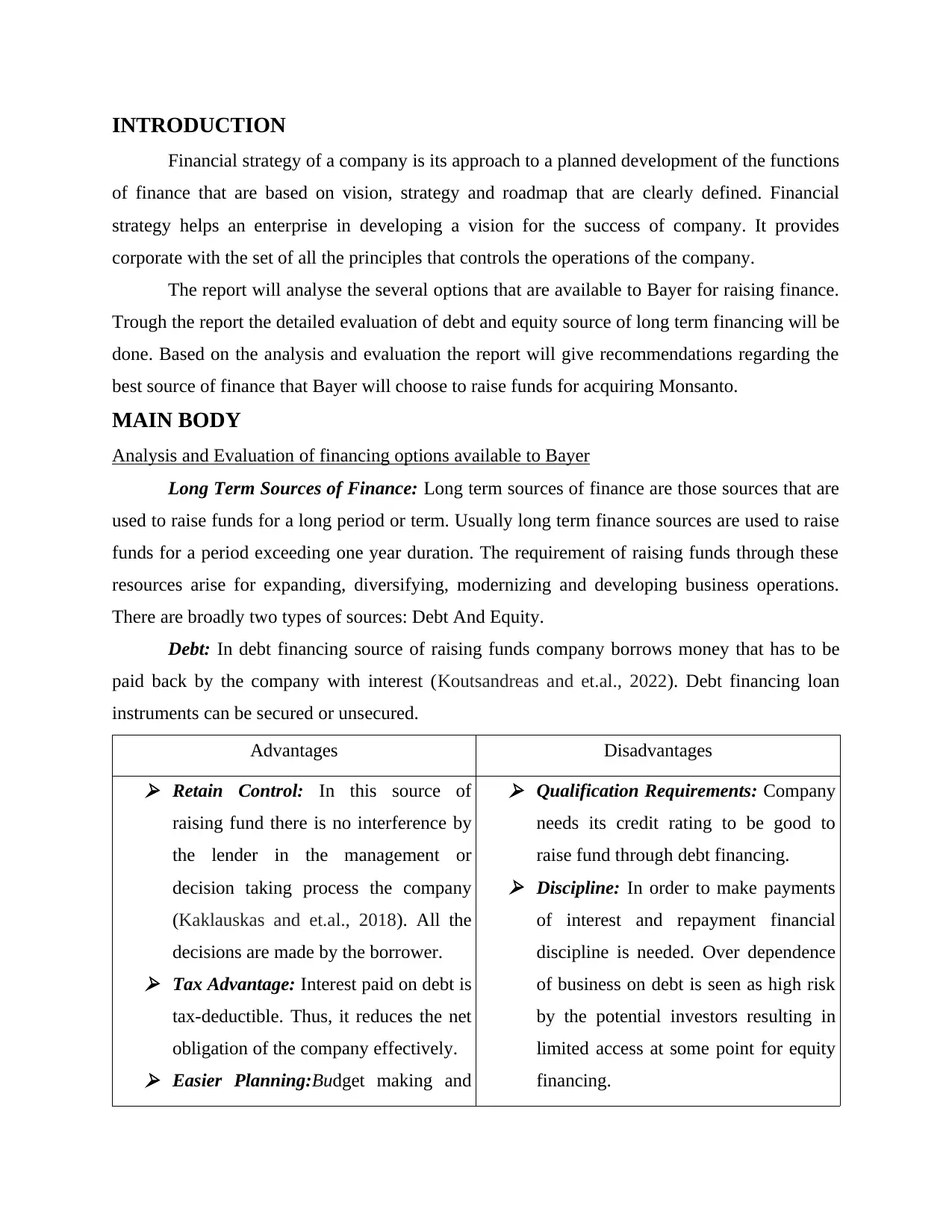
INTRODUCTION
Financial strategy of a company is its approach to a planned development of the functions
of finance that are based on vision, strategy and roadmap that are clearly defined. Financial
strategy helps an enterprise in developing a vision for the success of company. It provides
corporate with the set of all the principles that controls the operations of the company.
The report will analyse the several options that are available to Bayer for raising finance.
Trough the report the detailed evaluation of debt and equity source of long term financing will be
done. Based on the analysis and evaluation the report will give recommendations regarding the
best source of finance that Bayer will choose to raise funds for acquiring Monsanto.
MAIN BODY
Analysis and Evaluation of financing options available to Bayer
Long Term Sources of Finance: Long term sources of finance are those sources that are
used to raise funds for a long period or term. Usually long term finance sources are used to raise
funds for a period exceeding one year duration. The requirement of raising funds through these
resources arise for expanding, diversifying, modernizing and developing business operations.
There are broadly two types of sources: Debt And Equity.
Debt: In debt financing source of raising funds company borrows money that has to be
paid back by the company with interest (Koutsandreas and et.al., 2022). Debt financing loan
instruments can be secured or unsecured.
Advantages Disadvantages Retain Control: In this source of
raising fund there is no interference by
the lender in the management or
decision taking process the company
(Kaklauskas and et.al., 2018). All the
decisions are made by the borrower. Tax Advantage: Interest paid on debt is
tax-deductible. Thus, it reduces the net
obligation of the company effectively. Easier Planning:Budget making and
Qualification Requirements: Company
needs its credit rating to be good to
raise fund through debt financing.
Discipline: In order to make payments
of interest and repayment financial
discipline is needed. Over dependence
of business on debt is seen as high risk
by the potential investors resulting in
limited access at some point for equity
financing.
Financial strategy of a company is its approach to a planned development of the functions
of finance that are based on vision, strategy and roadmap that are clearly defined. Financial
strategy helps an enterprise in developing a vision for the success of company. It provides
corporate with the set of all the principles that controls the operations of the company.
The report will analyse the several options that are available to Bayer for raising finance.
Trough the report the detailed evaluation of debt and equity source of long term financing will be
done. Based on the analysis and evaluation the report will give recommendations regarding the
best source of finance that Bayer will choose to raise funds for acquiring Monsanto.
MAIN BODY
Analysis and Evaluation of financing options available to Bayer
Long Term Sources of Finance: Long term sources of finance are those sources that are
used to raise funds for a long period or term. Usually long term finance sources are used to raise
funds for a period exceeding one year duration. The requirement of raising funds through these
resources arise for expanding, diversifying, modernizing and developing business operations.
There are broadly two types of sources: Debt And Equity.
Debt: In debt financing source of raising funds company borrows money that has to be
paid back by the company with interest (Koutsandreas and et.al., 2022). Debt financing loan
instruments can be secured or unsecured.
Advantages Disadvantages Retain Control: In this source of
raising fund there is no interference by
the lender in the management or
decision taking process the company
(Kaklauskas and et.al., 2018). All the
decisions are made by the borrower. Tax Advantage: Interest paid on debt is
tax-deductible. Thus, it reduces the net
obligation of the company effectively. Easier Planning:Budget making and
Qualification Requirements: Company
needs its credit rating to be good to
raise fund through debt financing.
Discipline: In order to make payments
of interest and repayment financial
discipline is needed. Over dependence
of business on debt is seen as high risk
by the potential investors resulting in
limited access at some point for equity
financing.

preparation of financial plans become
easier as there exist exact advance
knowledge regarding the amount of
interest and principal to be made each
month.
Collateral: The assets of the business
are put at risk as for raising fund
borrower agrees to provide collateral to
the lender (Wu, 2019).
Issue of Bonds: Issue of bonds works as a loan between a corporation and an investor.
The corporation receives the money from the investors that he agrees to pay for a certain period
in exchange for interest payments periodically by the corporation. At the end of the specific
period the corporation pays back the amount to the investor.
Types of Bonds
Convertible Bonds: A convertible bond is a corporate debt security with a fixed income,
yielding interest payments, these can be converted into equity shares or common stock into a
predetermined number (Brusov, Filatova and Orekhova, 2021). It may happen that as per the
discretion of the bondholder the conversion to bond takes place during the life of bond.
Non Convertible Bonds: A non-convertible bonds are bonds that do not get converted
into equity shares or common stock. Non convertible bonds have fixed maturity date. The
amount of interest with the principal amount can be paid monthly, quarterly or annually.
Pros Cons Bondholders receive only a fixed and
limited income until conversion: It is
advantageous for the company as the
availability of operating income for
common stock holders is large.
Operating income is required to be
shared with new converted
shareholders with the company
performs well. Common stockholder holds the voting
control: The bond holders are not
Right in the hands of company for
forceful conversion: Call for forced
conversion by be made by the issuing
corporation as it has authority to do. It
usually happens when stock price id
higher than the price of bond.
Complex security: The characteristics
of convertible bonds creates confusion
regarding stocks and bonds for the new
investors.
Risk: In case of bankruptcy of the
easier as there exist exact advance
knowledge regarding the amount of
interest and principal to be made each
month.
Collateral: The assets of the business
are put at risk as for raising fund
borrower agrees to provide collateral to
the lender (Wu, 2019).
Issue of Bonds: Issue of bonds works as a loan between a corporation and an investor.
The corporation receives the money from the investors that he agrees to pay for a certain period
in exchange for interest payments periodically by the corporation. At the end of the specific
period the corporation pays back the amount to the investor.
Types of Bonds
Convertible Bonds: A convertible bond is a corporate debt security with a fixed income,
yielding interest payments, these can be converted into equity shares or common stock into a
predetermined number (Brusov, Filatova and Orekhova, 2021). It may happen that as per the
discretion of the bondholder the conversion to bond takes place during the life of bond.
Non Convertible Bonds: A non-convertible bonds are bonds that do not get converted
into equity shares or common stock. Non convertible bonds have fixed maturity date. The
amount of interest with the principal amount can be paid monthly, quarterly or annually.
Pros Cons Bondholders receive only a fixed and
limited income until conversion: It is
advantageous for the company as the
availability of operating income for
common stock holders is large.
Operating income is required to be
shared with new converted
shareholders with the company
performs well. Common stockholder holds the voting
control: The bond holders are not
Right in the hands of company for
forceful conversion: Call for forced
conversion by be made by the issuing
corporation as it has authority to do. It
usually happens when stock price id
higher than the price of bond.
Complex security: The characteristics
of convertible bonds creates confusion
regarding stocks and bonds for the new
investors.
Risk: In case of bankruptcy of the
Secure Best Marks with AI Grader
Need help grading? Try our AI Grader for instant feedback on your assignments.
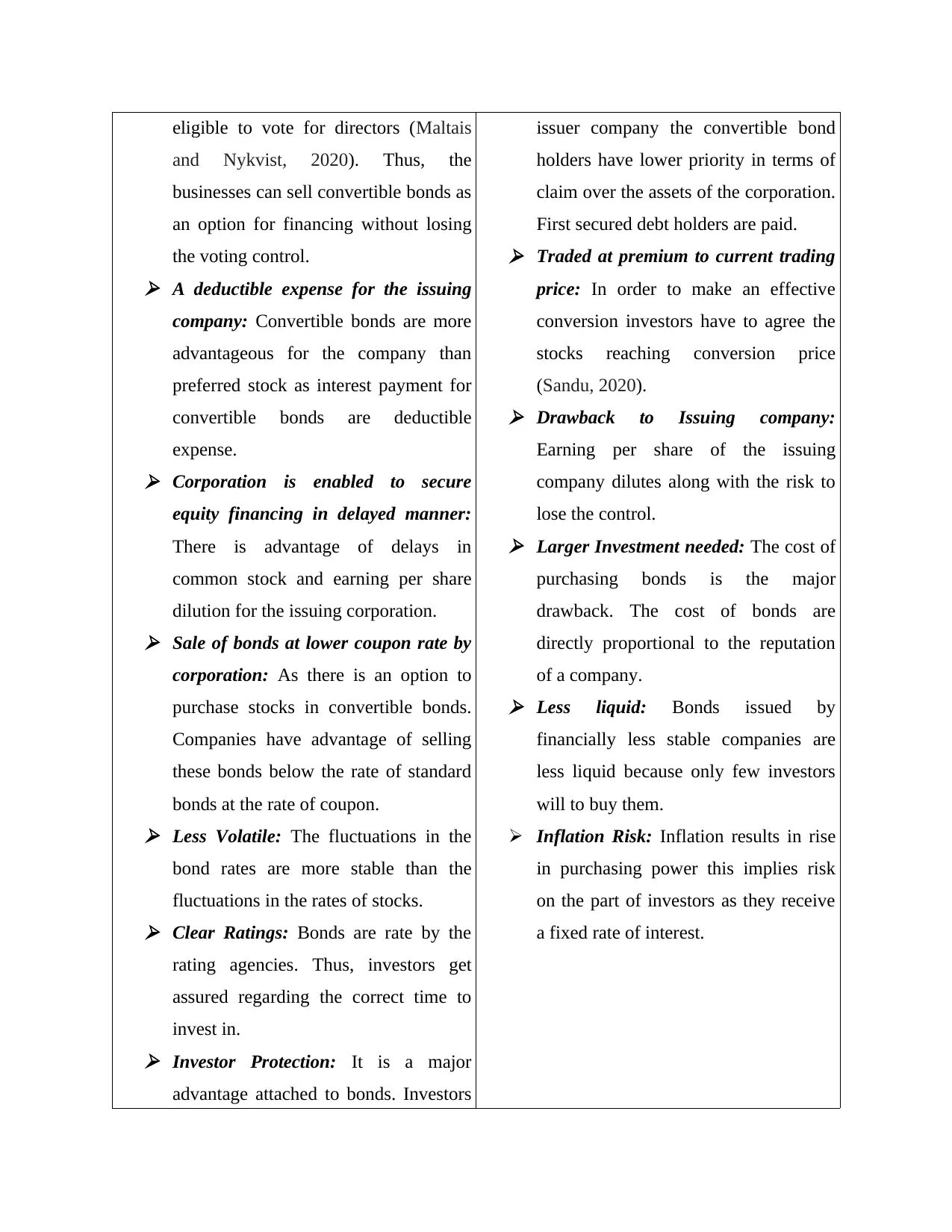
eligible to vote for directors (Maltais
and Nykvist, 2020). Thus, the
businesses can sell convertible bonds as
an option for financing without losing
the voting control. A deductible expense for the issuing
company: Convertible bonds are more
advantageous for the company than
preferred stock as interest payment for
convertible bonds are deductible
expense. Corporation is enabled to secure
equity financing in delayed manner:
There is advantage of delays in
common stock and earning per share
dilution for the issuing corporation. Sale of bonds at lower coupon rate by
corporation: As there is an option to
purchase stocks in convertible bonds.
Companies have advantage of selling
these bonds below the rate of standard
bonds at the rate of coupon. Less Volatile: The fluctuations in the
bond rates are more stable than the
fluctuations in the rates of stocks. Clear Ratings: Bonds are rate by the
rating agencies. Thus, investors get
assured regarding the correct time to
invest in. Investor Protection: It is a major
advantage attached to bonds. Investors
issuer company the convertible bond
holders have lower priority in terms of
claim over the assets of the corporation.
First secured debt holders are paid.
Traded at premium to current trading
price: In order to make an effective
conversion investors have to agree the
stocks reaching conversion price
(Sandu, 2020).
Drawback to Issuing company:
Earning per share of the issuing
company dilutes along with the risk to
lose the control.
Larger Investment needed: The cost of
purchasing bonds is the major
drawback. The cost of bonds are
directly proportional to the reputation
of a company.
Less liquid: Bonds issued by
financially less stable companies are
less liquid because only few investors
will to buy them.
Inflation Risk: Inflation results in rise
in purchasing power this implies risk
on the part of investors as they receive
a fixed rate of interest.
and Nykvist, 2020). Thus, the
businesses can sell convertible bonds as
an option for financing without losing
the voting control. A deductible expense for the issuing
company: Convertible bonds are more
advantageous for the company than
preferred stock as interest payment for
convertible bonds are deductible
expense. Corporation is enabled to secure
equity financing in delayed manner:
There is advantage of delays in
common stock and earning per share
dilution for the issuing corporation. Sale of bonds at lower coupon rate by
corporation: As there is an option to
purchase stocks in convertible bonds.
Companies have advantage of selling
these bonds below the rate of standard
bonds at the rate of coupon. Less Volatile: The fluctuations in the
bond rates are more stable than the
fluctuations in the rates of stocks. Clear Ratings: Bonds are rate by the
rating agencies. Thus, investors get
assured regarding the correct time to
invest in. Investor Protection: It is a major
advantage attached to bonds. Investors
issuer company the convertible bond
holders have lower priority in terms of
claim over the assets of the corporation.
First secured debt holders are paid.
Traded at premium to current trading
price: In order to make an effective
conversion investors have to agree the
stocks reaching conversion price
(Sandu, 2020).
Drawback to Issuing company:
Earning per share of the issuing
company dilutes along with the risk to
lose the control.
Larger Investment needed: The cost of
purchasing bonds is the major
drawback. The cost of bonds are
directly proportional to the reputation
of a company.
Less liquid: Bonds issued by
financially less stable companies are
less liquid because only few investors
will to buy them.
Inflation Risk: Inflation results in rise
in purchasing power this implies risk
on the part of investors as they receive
a fixed rate of interest.
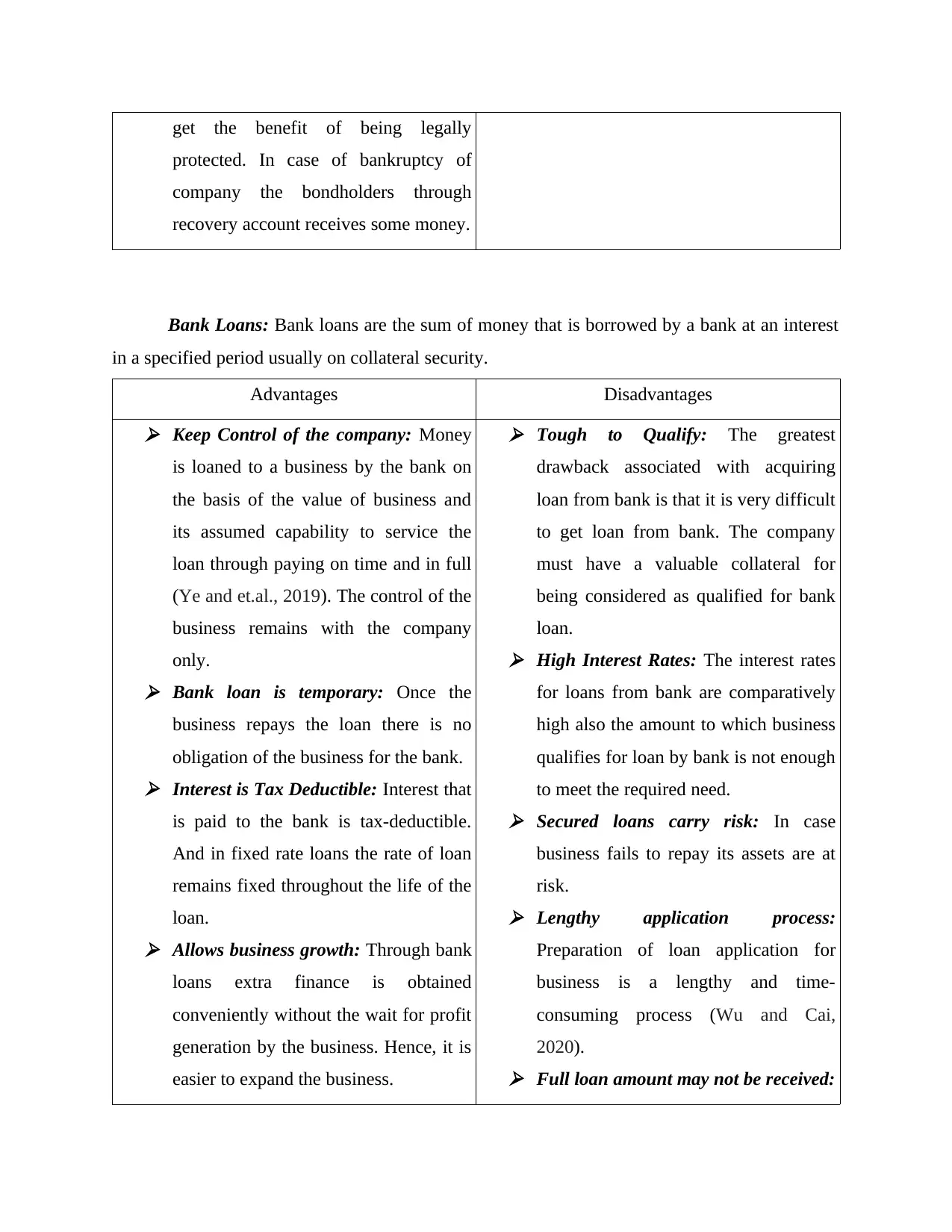
get the benefit of being legally
protected. In case of bankruptcy of
company the bondholders through
recovery account receives some money.
Bank Loans: Bank loans are the sum of money that is borrowed by a bank at an interest
in a specified period usually on collateral security.
Advantages Disadvantages Keep Control of the company: Money
is loaned to a business by the bank on
the basis of the value of business and
its assumed capability to service the
loan through paying on time and in full
(Ye and et.al., 2019). The control of the
business remains with the company
only. Bank loan is temporary: Once the
business repays the loan there is no
obligation of the business for the bank. Interest is Tax Deductible: Interest that
is paid to the bank is tax-deductible.
And in fixed rate loans the rate of loan
remains fixed throughout the life of the
loan. Allows business growth: Through bank
loans extra finance is obtained
conveniently without the wait for profit
generation by the business. Hence, it is
easier to expand the business.
Tough to Qualify: The greatest
drawback associated with acquiring
loan from bank is that it is very difficult
to get loan from bank. The company
must have a valuable collateral for
being considered as qualified for bank
loan.
High Interest Rates: The interest rates
for loans from bank are comparatively
high also the amount to which business
qualifies for loan by bank is not enough
to meet the required need.
Secured loans carry risk: In case
business fails to repay its assets are at
risk.
Lengthy application process:
Preparation of loan application for
business is a lengthy and time-
consuming process (Wu and Cai,
2020).
Full loan amount may not be received:
protected. In case of bankruptcy of
company the bondholders through
recovery account receives some money.
Bank Loans: Bank loans are the sum of money that is borrowed by a bank at an interest
in a specified period usually on collateral security.
Advantages Disadvantages Keep Control of the company: Money
is loaned to a business by the bank on
the basis of the value of business and
its assumed capability to service the
loan through paying on time and in full
(Ye and et.al., 2019). The control of the
business remains with the company
only. Bank loan is temporary: Once the
business repays the loan there is no
obligation of the business for the bank. Interest is Tax Deductible: Interest that
is paid to the bank is tax-deductible.
And in fixed rate loans the rate of loan
remains fixed throughout the life of the
loan. Allows business growth: Through bank
loans extra finance is obtained
conveniently without the wait for profit
generation by the business. Hence, it is
easier to expand the business.
Tough to Qualify: The greatest
drawback associated with acquiring
loan from bank is that it is very difficult
to get loan from bank. The company
must have a valuable collateral for
being considered as qualified for bank
loan.
High Interest Rates: The interest rates
for loans from bank are comparatively
high also the amount to which business
qualifies for loan by bank is not enough
to meet the required need.
Secured loans carry risk: In case
business fails to repay its assets are at
risk.
Lengthy application process:
Preparation of loan application for
business is a lengthy and time-
consuming process (Wu and Cai,
2020).
Full loan amount may not be received:
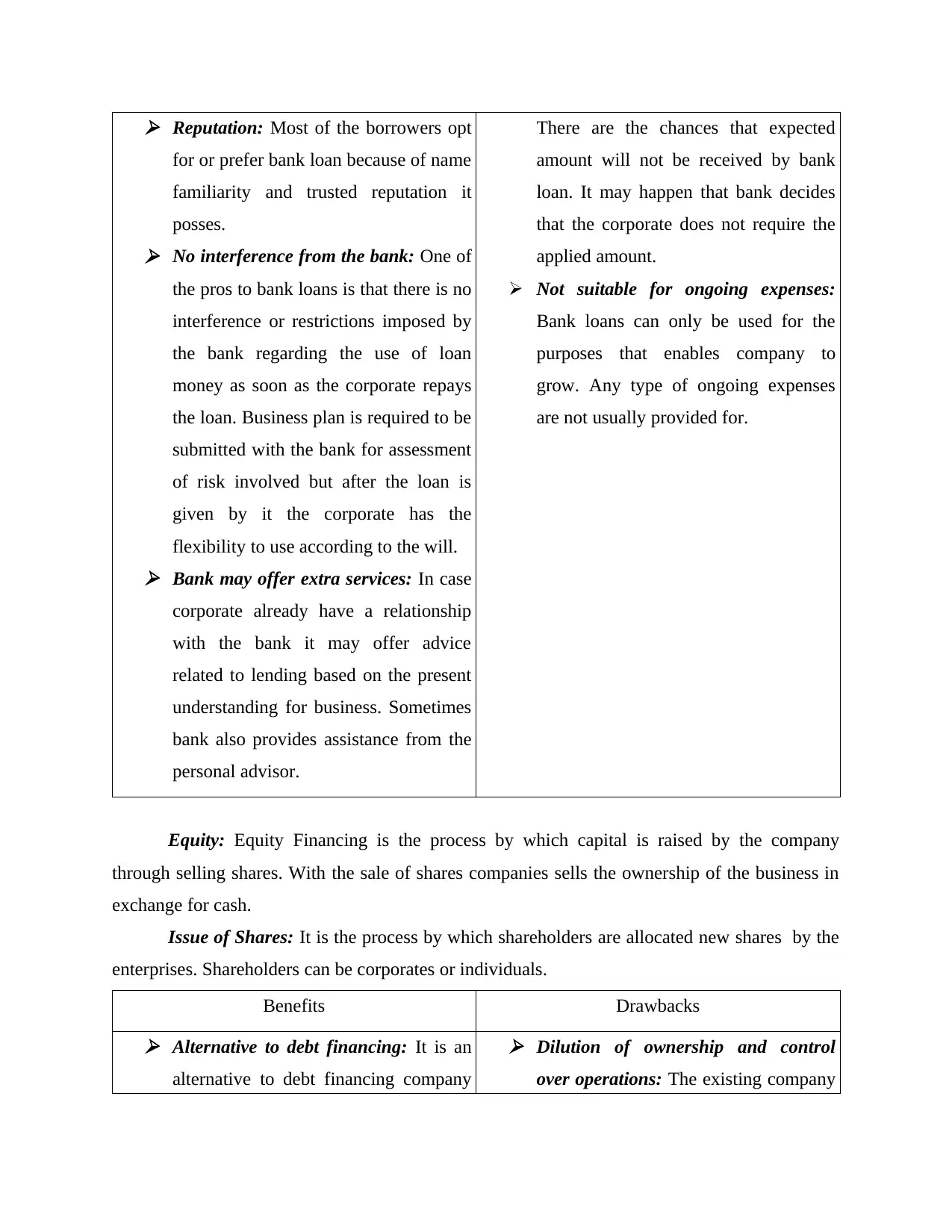
Reputation: Most of the borrowers opt
for or prefer bank loan because of name
familiarity and trusted reputation it
posses. No interference from the bank: One of
the pros to bank loans is that there is no
interference or restrictions imposed by
the bank regarding the use of loan
money as soon as the corporate repays
the loan. Business plan is required to be
submitted with the bank for assessment
of risk involved but after the loan is
given by it the corporate has the
flexibility to use according to the will. Bank may offer extra services: In case
corporate already have a relationship
with the bank it may offer advice
related to lending based on the present
understanding for business. Sometimes
bank also provides assistance from the
personal advisor.
There are the chances that expected
amount will not be received by bank
loan. It may happen that bank decides
that the corporate does not require the
applied amount.
Not suitable for ongoing expenses:
Bank loans can only be used for the
purposes that enables company to
grow. Any type of ongoing expenses
are not usually provided for.
Equity: Equity Financing is the process by which capital is raised by the company
through selling shares. With the sale of shares companies sells the ownership of the business in
exchange for cash.
Issue of Shares: It is the process by which shareholders are allocated new shares by the
enterprises. Shareholders can be corporates or individuals.
Benefits Drawbacks Alternative to debt financing: It is an
alternative to debt financing company
Dilution of ownership and control
over operations: The existing company
for or prefer bank loan because of name
familiarity and trusted reputation it
posses. No interference from the bank: One of
the pros to bank loans is that there is no
interference or restrictions imposed by
the bank regarding the use of loan
money as soon as the corporate repays
the loan. Business plan is required to be
submitted with the bank for assessment
of risk involved but after the loan is
given by it the corporate has the
flexibility to use according to the will. Bank may offer extra services: In case
corporate already have a relationship
with the bank it may offer advice
related to lending based on the present
understanding for business. Sometimes
bank also provides assistance from the
personal advisor.
There are the chances that expected
amount will not be received by bank
loan. It may happen that bank decides
that the corporate does not require the
applied amount.
Not suitable for ongoing expenses:
Bank loans can only be used for the
purposes that enables company to
grow. Any type of ongoing expenses
are not usually provided for.
Equity: Equity Financing is the process by which capital is raised by the company
through selling shares. With the sale of shares companies sells the ownership of the business in
exchange for cash.
Issue of Shares: It is the process by which shareholders are allocated new shares by the
enterprises. Shareholders can be corporates or individuals.
Benefits Drawbacks Alternative to debt financing: It is an
alternative to debt financing company
Dilution of ownership and control
over operations: The existing company
Paraphrase This Document
Need a fresh take? Get an instant paraphrase of this document with our AI Paraphraser
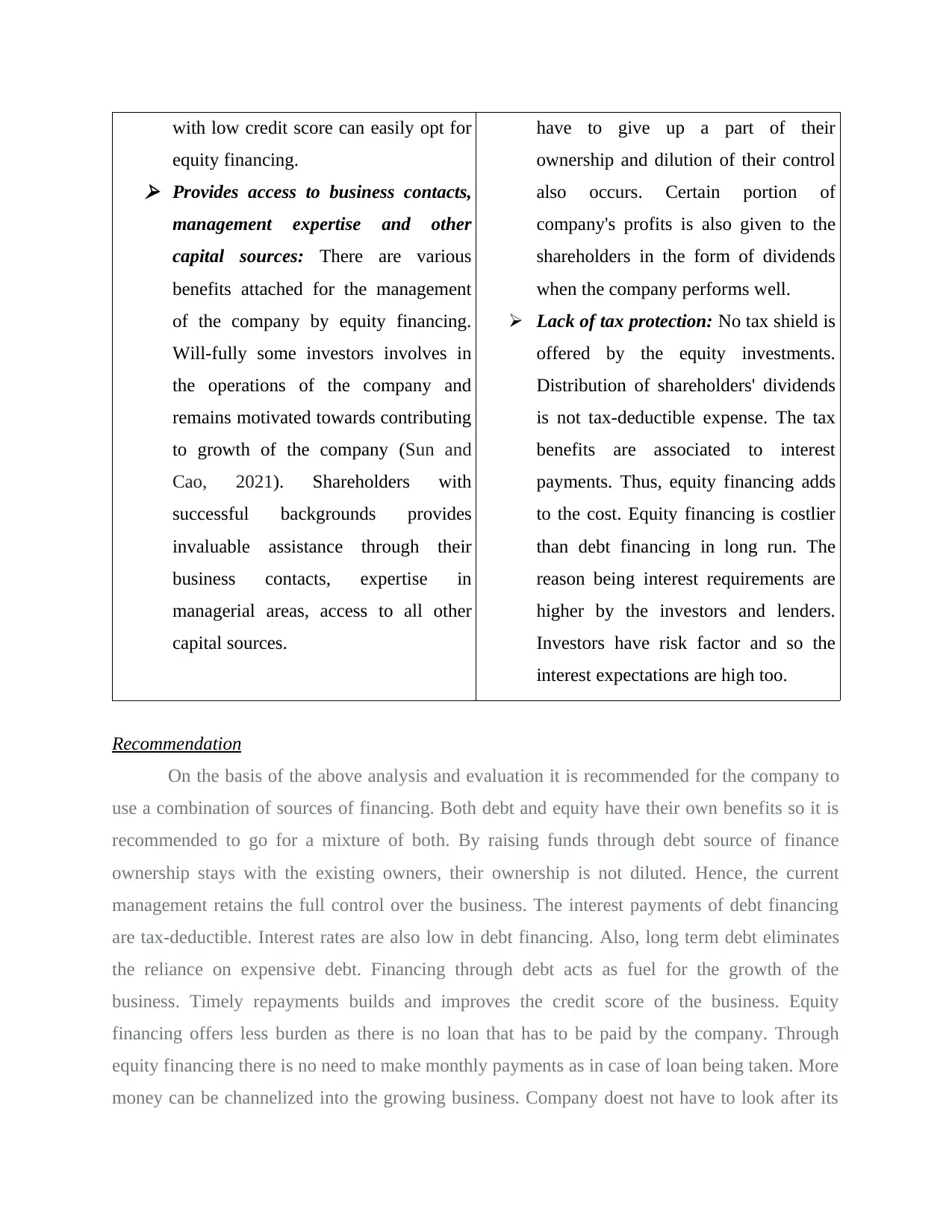
with low credit score can easily opt for
equity financing. Provides access to business contacts,
management expertise and other
capital sources: There are various
benefits attached for the management
of the company by equity financing.
Will-fully some investors involves in
the operations of the company and
remains motivated towards contributing
to growth of the company (Sun and
Cao, 2021). Shareholders with
successful backgrounds provides
invaluable assistance through their
business contacts, expertise in
managerial areas, access to all other
capital sources.
have to give up a part of their
ownership and dilution of their control
also occurs. Certain portion of
company's profits is also given to the
shareholders in the form of dividends
when the company performs well.
Lack of tax protection: No tax shield is
offered by the equity investments.
Distribution of shareholders' dividends
is not tax-deductible expense. The tax
benefits are associated to interest
payments. Thus, equity financing adds
to the cost. Equity financing is costlier
than debt financing in long run. The
reason being interest requirements are
higher by the investors and lenders.
Investors have risk factor and so the
interest expectations are high too.
Recommendation
On the basis of the above analysis and evaluation it is recommended for the company to
use a combination of sources of financing. Both debt and equity have their own benefits so it is
recommended to go for a mixture of both. By raising funds through debt source of finance
ownership stays with the existing owners, their ownership is not diluted. Hence, the current
management retains the full control over the business. The interest payments of debt financing
are tax-deductible. Interest rates are also low in debt financing. Also, long term debt eliminates
the reliance on expensive debt. Financing through debt acts as fuel for the growth of the
business. Timely repayments builds and improves the credit score of the business. Equity
financing offers less burden as there is no loan that has to be paid by the company. Through
equity financing there is no need to make monthly payments as in case of loan being taken. More
money can be channelized into the growing business. Company doest not have to look after its
equity financing. Provides access to business contacts,
management expertise and other
capital sources: There are various
benefits attached for the management
of the company by equity financing.
Will-fully some investors involves in
the operations of the company and
remains motivated towards contributing
to growth of the company (Sun and
Cao, 2021). Shareholders with
successful backgrounds provides
invaluable assistance through their
business contacts, expertise in
managerial areas, access to all other
capital sources.
have to give up a part of their
ownership and dilution of their control
also occurs. Certain portion of
company's profits is also given to the
shareholders in the form of dividends
when the company performs well.
Lack of tax protection: No tax shield is
offered by the equity investments.
Distribution of shareholders' dividends
is not tax-deductible expense. The tax
benefits are associated to interest
payments. Thus, equity financing adds
to the cost. Equity financing is costlier
than debt financing in long run. The
reason being interest requirements are
higher by the investors and lenders.
Investors have risk factor and so the
interest expectations are high too.
Recommendation
On the basis of the above analysis and evaluation it is recommended for the company to
use a combination of sources of financing. Both debt and equity have their own benefits so it is
recommended to go for a mixture of both. By raising funds through debt source of finance
ownership stays with the existing owners, their ownership is not diluted. Hence, the current
management retains the full control over the business. The interest payments of debt financing
are tax-deductible. Interest rates are also low in debt financing. Also, long term debt eliminates
the reliance on expensive debt. Financing through debt acts as fuel for the growth of the
business. Timely repayments builds and improves the credit score of the business. Equity
financing offers less burden as there is no loan that has to be paid by the company. Through
equity financing there is no need to make monthly payments as in case of loan being taken. More
money can be channelized into the growing business. Company doest not have to look after its
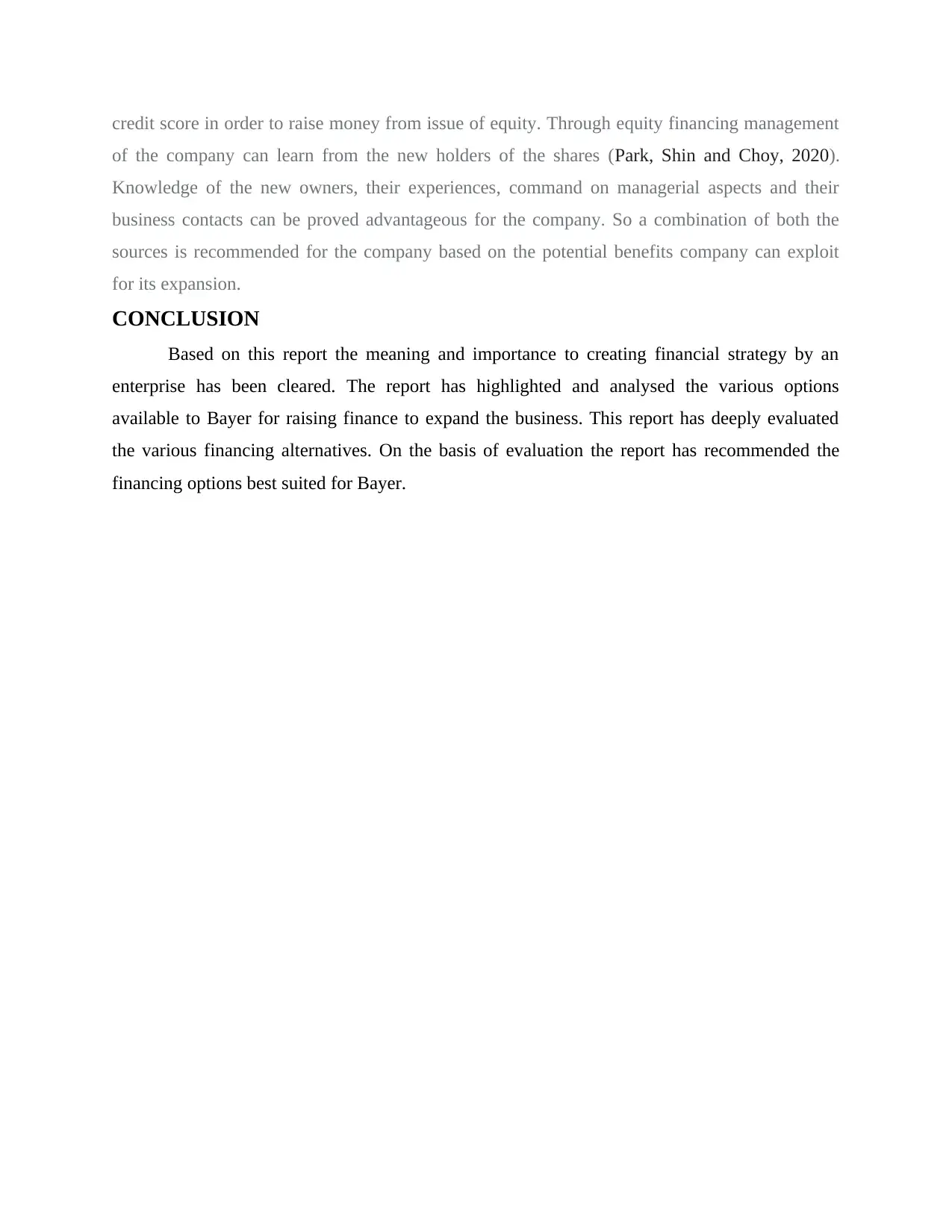
credit score in order to raise money from issue of equity. Through equity financing management
of the company can learn from the new holders of the shares (Park, Shin and Choy, 2020).
Knowledge of the new owners, their experiences, command on managerial aspects and their
business contacts can be proved advantageous for the company. So a combination of both the
sources is recommended for the company based on the potential benefits company can exploit
for its expansion.
CONCLUSION
Based on this report the meaning and importance to creating financial strategy by an
enterprise has been cleared. The report has highlighted and analysed the various options
available to Bayer for raising finance to expand the business. This report has deeply evaluated
the various financing alternatives. On the basis of evaluation the report has recommended the
financing options best suited for Bayer.
of the company can learn from the new holders of the shares (Park, Shin and Choy, 2020).
Knowledge of the new owners, their experiences, command on managerial aspects and their
business contacts can be proved advantageous for the company. So a combination of both the
sources is recommended for the company based on the potential benefits company can exploit
for its expansion.
CONCLUSION
Based on this report the meaning and importance to creating financial strategy by an
enterprise has been cleared. The report has highlighted and analysed the various options
available to Bayer for raising finance to expand the business. This report has deeply evaluated
the various financing alternatives. On the basis of evaluation the report has recommended the
financing options best suited for Bayer.

REFERENCES
Books and Journals
Brusov, P., Filatova, T. and Orekhova, N., 2021. The importance of rating and the disadvantages
of existing rating systems. In Ratings (pp. 7-14). Springer, Cham.
Kaklauskas, A. and et.al., 2018. An evaluation system for university–industry partnership
sustainability: Enhancing options for entrepreneurial universities. Sustainability. 10(1).
p.119.
Koutsandreas, D. and et.al., 2022. Risks and mitigation strategies in energy efficiency financing:
A systematic literature review. Energy Reports. 8. pp.1789-1802.
Maltais, A. and Nykvist, B., 2020. Understanding the role of green bonds in advancing
sustainability. Journal of Sustainable Finance & Investment, pp.1-20.
Park, G., Shin, S. R. and Choy, M., 2020. Early mover (dis) advantages and knowledge spillover
effects on blockchain startups’ funding and innovation performance. Journal of
Business Research. 109. pp.64-75.
Sandu, R. D., 2020. What is the profile of workers who build effective relationships with young
people facing severe and multiple disadvantages?. Journal of Community
Psychology. 48(2). pp.351-368.
Sun, Y. and Cao, Z., 2021, April. Financing Mode Analysis of Chinese Real Estate Enterprises–
A Case Study of Evergrande Group. In 2021 2nd Asia-Pacific Conference on Image
Processing, Electronics and Computers (pp. 524-530).
Wu, S. and Cai, Y., 2020, November. Financing structure and enterprise value: from the
perspective of sustainable growth. In Proceedings of the 2nd Africa-Asia Dialogue
Network (AADN) International Conference on Advances in Business Management and
Electronic Commerce Research (pp. 1-5).
Wu, S., 2019. Debt financing structure, ownership concentration and firm performance: a
comparison of the listed state-owned and non-state-owned CMNEs. Journal of Chinese
Economic and Business Studies. 17(2). pp.147-168.
Ye, Z. and et.al., 2019. The Impact of Bank Loan on Executive Perquisites under the Background
of Post-Split-Share Reform. Modern Economy. 10(07). p.1769.
1
Books and Journals
Brusov, P., Filatova, T. and Orekhova, N., 2021. The importance of rating and the disadvantages
of existing rating systems. In Ratings (pp. 7-14). Springer, Cham.
Kaklauskas, A. and et.al., 2018. An evaluation system for university–industry partnership
sustainability: Enhancing options for entrepreneurial universities. Sustainability. 10(1).
p.119.
Koutsandreas, D. and et.al., 2022. Risks and mitigation strategies in energy efficiency financing:
A systematic literature review. Energy Reports. 8. pp.1789-1802.
Maltais, A. and Nykvist, B., 2020. Understanding the role of green bonds in advancing
sustainability. Journal of Sustainable Finance & Investment, pp.1-20.
Park, G., Shin, S. R. and Choy, M., 2020. Early mover (dis) advantages and knowledge spillover
effects on blockchain startups’ funding and innovation performance. Journal of
Business Research. 109. pp.64-75.
Sandu, R. D., 2020. What is the profile of workers who build effective relationships with young
people facing severe and multiple disadvantages?. Journal of Community
Psychology. 48(2). pp.351-368.
Sun, Y. and Cao, Z., 2021, April. Financing Mode Analysis of Chinese Real Estate Enterprises–
A Case Study of Evergrande Group. In 2021 2nd Asia-Pacific Conference on Image
Processing, Electronics and Computers (pp. 524-530).
Wu, S. and Cai, Y., 2020, November. Financing structure and enterprise value: from the
perspective of sustainable growth. In Proceedings of the 2nd Africa-Asia Dialogue
Network (AADN) International Conference on Advances in Business Management and
Electronic Commerce Research (pp. 1-5).
Wu, S., 2019. Debt financing structure, ownership concentration and firm performance: a
comparison of the listed state-owned and non-state-owned CMNEs. Journal of Chinese
Economic and Business Studies. 17(2). pp.147-168.
Ye, Z. and et.al., 2019. The Impact of Bank Loan on Executive Perquisites under the Background
of Post-Split-Share Reform. Modern Economy. 10(07). p.1769.
1
1 out of 10
Related Documents
Your All-in-One AI-Powered Toolkit for Academic Success.
+13062052269
info@desklib.com
Available 24*7 on WhatsApp / Email
![[object Object]](/_next/static/media/star-bottom.7253800d.svg)
Unlock your academic potential
© 2024 | Zucol Services PVT LTD | All rights reserved.




